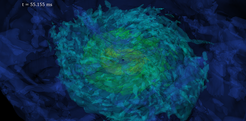Formation of compact objects and multi-messenger astronomy
PhD theses on those topics will involve the AEI, the University of Potsdam, and the Leibniz Institute for Astrophysics.
Since the discovery of GW150914, several binary black holes have been observed by LIGO and Virgo with component masses in the range of 5–40 solar masses. Such stellar-mass black holes are likely to be formed through core-collapse of massive stars. However, the formation process is still poorly understood, and it remains an open issue. We also know that most galaxies host at their center supermassive black holes with masses in the range of 106–1010 solar masses. The formation mechanism of these black holes is also poorly understood, and is one of the longest-standing problems in astrophysics and general relativity.
To clarify the formation process of these black holes, observations are obviously required and are very relevant. During the formation of stellar-mass black holes, electromagnetic signals, as well as gravitational waves are likely to be emitted transiently - for example, when a rapidly spinning black hole forms, a long gamma-ray burst is believed to take place. Because this phenomenon occurs in an environment of strong gravity, high density, and high temperature, transient electromagnetic signals are expected to be emitted in a wide range of wavelengths. If detected, these electromagnetic signals will unveil precious and unique information on the black hole formation process. This is also the case for the formation of binary black holes in close orbits. Transient electromagnetic signals for a wide range of wavelengths like in the case of long and short gamma-ray bursts may be observed by future high-sensitivity observational telescopes of transient phenomena like the Large Synoptic Survey Telescope (LSST) as well as the Zwicky Transient Factory (ZTF) and the Dark Energy Camera (DECam) now in operation, and it is an urgent task to establish reliable models for them.

As explained above, the scenarios for the formation of supermassive black holes are not clear. However, in some scenarios like the direct collapse of supermassive stars to a supermassive black hole high-amplitude gravitational waves together with a transient electromagnetic signal are expected to be emitted. In this case, the gravitational wave signal could be observed by LISA, while the transient electromagnetic signal could be detected by future electromagnetic telescopes, such as LSST and the Wide Field Infrared Survey Telescope (WFIRST).
Graduate students in the IMPRS will be able to tackle projects in a wide range of topics in black hole astrophysics, in particular their formation mechanism and associated electromagnetic signals. Theoretical studies of black hole formation will be carried out through numerical relativity simulations, solving a large set of equations, which take into account several relevant physical phenomena.
